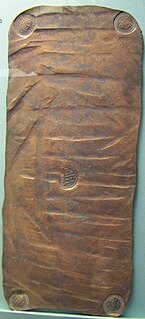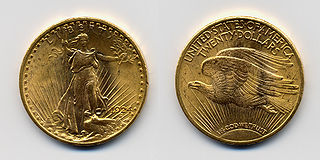A currency, in the most specific use of the word, refers to money in any form when in use or circulation as a medium of exchange, especially circulating banknotes and coins. A more general definition is that a currency is a system of money in common use, especially for people in a nation. Under this definition, US dollars, British pounds, Australian dollars, European euros and Russian ruble are examples of currency. These various currencies are recognized as stores of value and are traded between nations in foreign exchange markets, which determine the relative values of the different currencies. Currencies in this sense are defined by governments, and each type has limited boundaries of acceptance.

A gold standard is a monetary system in which the standard economic unit of account is based on a fixed quantity of gold. Three types can be distinguished: specie, bullion, and exchange.
The Specie Payment Resumption Act of January 14, 1875 was a law in the United States that restored the nation to the gold standard through the redemption of previously-unbacked United States Notes and reversed inflationary government policies promoted directly after the American Civil War. The decision further contracted the nation's money supply and was seen by critics as an exacerbating factor of the so-called Long Depression, which struck in 1873.

The riksdaler was the name of a Swedish coin first minted in 1604. Between 1777 and 1873, it was the currency of Sweden. The daler, like the dollar, was named after the German Thaler. The similarly named Reichsthaler, rijksdaalder, and rigsdaler were used in Germany and Austria-Hungary, the Netherlands, and Denmark-Norway, respectively. Riksdaler is still used as a colloquial term for Sweden's modern-day currency.

A banknote is a type of negotiable promissory note, made by a bank, payable to the bearer on demand.
Banknotes were originally issued by commercial banks, which were legally required to redeem the notes for legal tender when presented to the chief cashier of the originating bank. These commercial banknotes only traded at face value in the market served by the issuing bank. Commercial banknotes have primarily been replaced by national banknotes issued by central banks.

The Panic of 1837 was a financial crisis in the United States that touched off a major recession that lasted until the mid-1840s. Profits, prices, and wages went down while unemployment went up. Pessimism abounded during the time. The panic had both domestic and foreign origins. Speculative lending practices in western states, a sharp decline in cotton prices, a collapsing land bubble, international specie flows, and restrictive lending policies in Great Britain were all to blame. On May 10, 1837, banks in New York City suspended specie payments, meaning that they would no longer redeem commercial paper in specie at full face value. Despite a brief recovery in 1838, the recession persisted for approximately seven years. Banks collapsed, businesses failed, prices declined, and thousands of workers lost their jobs. Unemployment may have been as high as 25% in some locales. The years 1837 to 1844 were, generally speaking, years of deflation in wages and prices.

Hard money policies support a specie standard, usually gold or silver, typically implemented with representative money.

The rigsdaler was the name of several currencies used in Denmark until 1875. The similarly named Reichsthaler, riksdaler and rijksdaalder were used in Germany and Austria-Hungary, Sweden and the Netherlands, respectively. These currencies were often anglicized as rix-dollar or rixdollar.
The Independent Treasury was the system for managing the money supply of the United States federal government through the U.S. Treasury and its sub-treasuries, independently of the national banking and financial systems. It was created on August 6, 1846 by the 29th Congress, with the enactment of the Independent Treasury Act of 1846, and it functioned until the early 20th century, when the Federal Reserve System replaced it. During this time, the Treasury took over an ever-larger number of functions of a central bank and the Treasury Department came to be the major force in the U.S. money market.

Early American currency went through several stages of development during the colonial and post-Revolutionary history of the United States. Because few coins were minted in the thirteen colonies that became the United States, foreign coins like the Spanish dollar were widely circulated. Colonial governments sometimes issued paper money to facilitate economic activities. The British Parliament passed Currency Acts in 1751, 1764, and 1773 that regulated colonial paper money.
A coin is a small, flat, round piece of metal or plastic that is used as money.

The pound was the currency of the Commonwealth of Massachusetts and its colonial predecessors until 1793. Like the British pound sterling of that era, the Massachusetts pound was subdivided into 20 shillings, each of 12 pence, but the Massachusetts and British pounds were not equivalent in value. British and other foreign coins were widely circulated in Massachusetts, supplemented by locally produced coins between about 1652 and 1682 and by local paper money from 1690.

Fractional currency, also referred to as shinplasters, was introduced by the United States federal government following the outbreak of the Civil War. These fractional notes were in use between 21 August 1862 and 15 February 1876, and issued in 3, 5, 10, 15, 25, and 50 cent denominations across five issuing periods. The complete type set below is part of the National Numismatic Collection, housed at the National Museum of American History, part of the Smithsonian Institution.

Money is any item or verifiable record that is generally accepted as payment for goods and services and repayment of debts, such as taxes, in a particular country or socio-economic context. The main functions of money are distinguished as: a medium of exchange, a unit of account, a store of value and sometimes, a standard of deferred payment. Any item or verifiable record that fulfils these functions can be considered as money.

The rigsdaler was the unit of currency used in Norway until 1816 and in Denmark until 1873. The similarly named Reichsthaler, riksdaler and rijksdaalder were used in Germany and Austria-Hungary, Sweden and the Netherlands, respectively.

Hard-times tokens are American large or half cent-sized copper tokens, struck from about 1833 through 1843, serving as unofficial currency. These privately made pieces, comprising merchant, political and satirical pieces, were used during a time of political and financial crisis in the United States.

The state Bank of Indiana was a government chartered banking institution established in 1833 in response to the state's shortage of capital caused by the closure of the Second Bank of the United States by the administration of President Andrew Jackson. The bank operated for twenty-six years and allowed the state to finance its internal improvements, stabilized the state's currency problems, and encouraged greater private economic growth. The bank closed in 1859. The profits were then split between the shareholders, allowing depositors to exchange their bank notes for federal notes, and the bank's buildings and infrastructure were sold and reincorporated as the privately owned Second Bank of Indiana.

Fiat money is a currency without intrinsic value that has been established as money, often by government regulation. Fiat money does not have use value, and has value only because a government maintains its value, or because parties engaging in exchange agree on its value. It was introduced as an alternative to commodity money and representative money. Commodity money is created from a good, often a precious metal such as gold or silver, which has uses other than as a medium of exchange. Representative money is similar to fiat money, but it represents a claim on a commodity.

The Coinage Act of 1857 was an act of the United States Congress which ended the status of foreign coins as legal tender, repealing all acts "authorizing the currency of foreign gold or silver coins". Specific coins would be exchanged at the Treasury and re-coined. The act is divided into seven sections.
Bakırcı Ahmed Pasha was an Ottoman statesman. He served as the governor of Egypt between 1633 and 1635.















